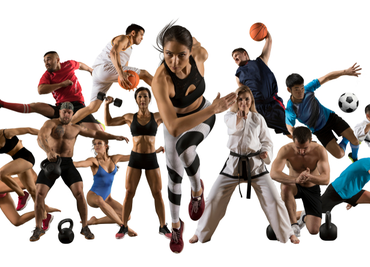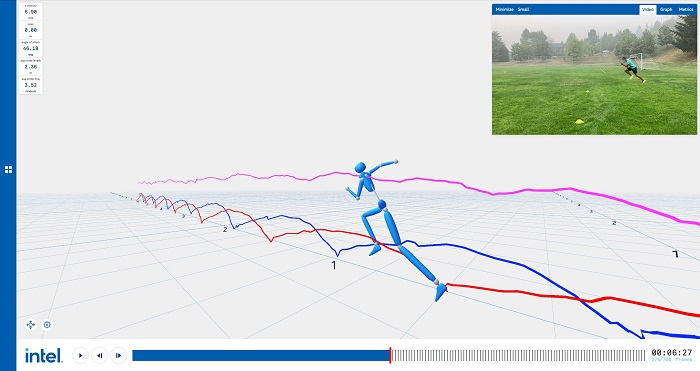Intel AI-Based Video Analysis Gives Athletes Critical Training Help in New Pilot Project

Coaches and trainers already work hard to help athletes increase their performance in competition, but a new AI-based tool from Intel Corp. is generating critical new data for coaches and trainers that could boost athletic abilities even more.
Announced in early 2019, the nascent AI and video-based Intel 3D Athlete Tracking (3DAT) technology is now being piloted for the first time with a group of college athletes who are pursuing their dreams of turning pro.
The pilot, which is being conducted by athletic performance specialists, EXOS, is using 3DATs deep learning and computer vision AI models to identify more than 20 key points on an athlete’s body taken from video captured using a smartphone, video camera or other devices. The pilot began in September 2020 and is being used presently with college athletes who are working to prepare for upcoming NFL drafts and player combines.
From the 3DAT-enhanced videos, coaches and trainers can then extract intricate real-time biomechanical data without having athletes having to wear special sensors or suits to collect the information, according to Intel. AI is used by 3DAT to generate and recreate an athlete’s resulting 3D skeleton from one or more video angles to allow such an analysis. The AI models used in 3DAT were developed by Intel.

Intel's 3D Athlete Tracking application shows velocity, acceleration and bio-mechanics from a sprint in this image. 3DAT sends video images to the cloud for analysis on Intel Xeon Scalable processors with built-in Intel Deep Learning Boost AI acceleration capabilities. (Image credit: Intel Corporation)
Through the pilot project, Intel hopes to gain insights and suggestions from coaches, trainers and athletes on how the system can be further improved and used in other industries.
“Athletes require very precise accurate information to train, especially the very elite athletes,” Jonathan Lee, Intel’s director of sports performance technology, told EnterpriseAI. “Those very minute changes are things that really are not detectable by the human eye.”
That’s where the AI-enhanced video analysis comes in to add context and detail, said Lee. “Based on just watching a video and seeing it, there are other things that you can't tell until you start to really analyze them at many times per second, and from multiple angles. 3DAT is putting relevant data at the fingertips of coaches and elite athletes that, up to this point, have either been nonexistent or hard to get.”
Lee, who works in Intel’s Olympic Technology Group, which works with the International Olympic Committee (IOC) to also bring this technology to the Games, said the resulting AI tools are being developed internally, while the company’s algorithms are models run on Intel’s Xeon scalable processors.
For the EXOS pilot, Intel streams the video up to the cloud and can also scale it down depending on how requirements, he said. The pilot runs on Intel Xeon Platinum 8275CL CPUs, but can also run on Intel's 11th Gen Core processors at the edge. The hands-free technology sends the video data at 60 frames per second to the cloud for analysis on the Xeon processors using built-in Intel Deep Learning Boost AI acceleration capabilities.
Coaches then receive reports and charts that provide a detailed overview of the athletes’ sessions. The coach can drill in deeper on body mechanics or trouble spots to better understand what minor tweaks they can implement to help athletes achieve their full athletic potential.
Its simple architecture means that it can be easily run by coaches and trainers on an athletic field on any kind of device, including a laptop or tablet computer, said Lee. “It’s actually important for us that we were able to optimize these models to run quickly on very few processors. It's also why we optimized these AI models using OpenVINO. It's an Intel platform that helps us to run these AI models, especially configured computer vision models, faster on our hardware.”
In addition to EXOS, Intel has also been working on 3DAT with athletic training clubs, especially in track and field, said Lee.
“For us it was important to not just bring AI and just say ‘hey here's AI, hit start to [use it],’ but really to just say, ‘alright, we know what AI can do,’” said Lee. “For us it was very important to work directly with the coaches to say, ‘this is what we can do to augment your coaching, to bring things that you didn't have before.’ The fact that it's lightweight, easily deployable, that it doesn't at all interfere with the training is huge.”
Previous technologies available to athletes often required them to wear restrictive or annoying physical sensors while they were training, said Lee. “Imagine a sprinter right who has to wear a bunch of sensors that interfere with her natural movements. But it also means that that even among very elite athletes, only a few actually get access to those technologies.”
The 3DAT system is getting positive feedback from many coaches who like that it is easy to use, available and because it has the ability to democratize the technology, said Lee.
EXOS did not make any athletes available to discuss how the 3DAT system was working for them.
But Ashton Eaton, a product development engineer in Intel’s Olympic Technology Group – and a two-time gold medal winner in the decathlon at the 2012 London and 2016 Rio de Janeiro Games – told EnterpriseAI that 3DAT could have played an important role in his training had it been available when he was competing.
“3DAT is a really interesting and powerful technology because there’s a massive gap in the sports world between what people feel when they do something and what they actually know that they’re doing,” said Eaton. “For example, when I was training for the 100-yard dash, I would get a certain feel in my body about what it felt like to run a certain speed, say 10.5 seconds. I would then go back to my coach and say, how do I run 10.4? And we would make certain adjustments that we thought would help and I’d run again. It might be 10.6 or it might be 10.4.”
Those adjustments were really just made through feel and conversation, added Eaton. “I didn’t actually know what my body was doing. And therefore, I didn’t actually know precisely what to change. What 3DAT does is allow the athlete or coach to understand precisely what their body is doing to get to the output that they got. So if they do make an adjustment, they are able to know exactly what to adjust in order to get faster or better.”
Eaton said that with results like that, he would have used 3DAT all the time to aim at his main goals of going higher, faster and stronger. “The main way to do that currently is through feel – what it feels like in the body. But with 3DAT, we can perform an action, get the feel and then see the actual data on what the body was doing. It allows us to be more informed about how to make an adjustment.”












